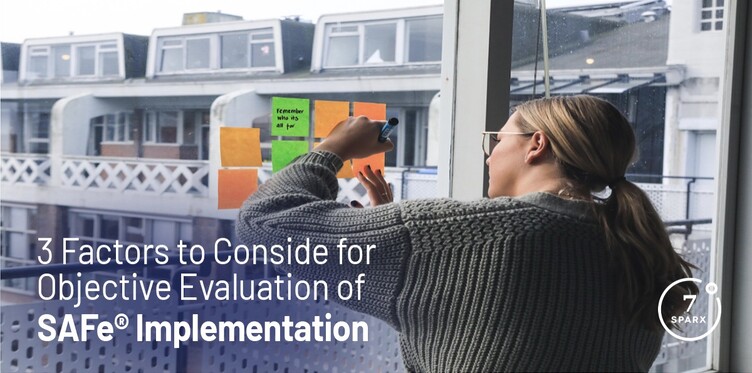
Category: Agile Leadership
3 Factors to Consider for Objective Evaluation of SAFe Implementation
Date of Release: August 1st, 2023
Reading Time: 03 mins

Written by Harsha Kondapalli
![]()
SAFe Practice Consultants endeavor to assist clients on their SAFe transformation journey within the dynamic agility consulting landscape. In my observation over the recent years, I identified three critical elements that organizations often overlook during their pursuit of SAFe implementation. Addressing these elements can result in significant and positive outcomes for the organizations’ transformation efforts if duly implemented.
Kindly take these pointers into consideration
1. Agile Release Trains (ARTs) Funding
It is essential to inquire whether the management’s funding approach aligns with Lean Portfolio Management (LPM) principles, emphasizing value-based funding, or if it simply constitutes a conventional top-down PMO funding. Below are a couple of observed anti-patterns related to this matter:
- The current approach to funding Agile Release Trains (ARTs) involves a centralized PMO with strict control over all financial transactions. However, this rigid and controlling PMO contradicts the principles of lean agility. For ARTs to truly embody lean and agile principles, they need to have visibility into how and where their delivered value and outcomes are recognized and appreciated. Without this understanding, their operations cannot be considered truly lean and agile.
- Instead of ARTs directly funding projects and activities, a more effective approach is to fund value streams using Lean budgets and guardrails. However, the current funding method often leads to confusion and misalignment. In this approach, value streams receive priority in the budgeting process, ensuring that resources and funds are strategically allocated to execute the most valuable components.
2. Value Stream Identification
To initiate the identification of workflows delivering value to customers, a value stream Workshop serves as the appropriate starting point. By utilizing value streams as the budget driver, funds are allocated to projects and activities that contribute the most value. Certain ARTs exhibit a purely technical focus, while others demonstrate a strong integration with the business. It is possible for an organization to conduct a value stream workshop and create a train that is entirely centered around technical aspects, devoid of substantial business integration.
A prime illustration of this scenario could involve transitioning from on-premises infrastructure to cloud migration or developing an early analytical tool as a proof of concept to support the business. In such cases, it is imperative for the Scrum Master and Product Owner to possess not only a comprehensive understanding of their agile roles and responsibilities but also to actively align themselves closely with the business vision and aim to achieve PI (Planning
Intervals) business objectives. The Product Owner should collaborate closely with the technical management to comprehend the ART’s vision and drive their activities in alignment with both the ART and business visions.
3. The Release Train Engineer (RTE) Role
The RTE (Release Train Engineer) plays a vital role on the train, ensuring that all the coaches (teams) stay on the rails (aligned and on track). However, there are instances where the RTE’s role is misconstrued and wrongly defined as a delivery lead. An anti-pattern that arises is the blending of the RTE and delivery lead roles, which can lead to issues with accountability, particularly concerning the ART backlog.
Delivery Leads primarily concentrate on delivering products to stakeholders and managing relationships with business partners. On the other hand, RTEs are dedicated to ensuring the train’s commitment to the PI, ensuring alignment with Agile principles. During the agile transformation journey, the RTE takes on the role of coaching the train, keeping all Scrum Masters and Product Owners on the ART (Agile Release Train) actively engaged and involved in the transformation process.
In my perspective, conducting an objective evaluation of SAFe implementation requires thorough examination of several factors. Key aspects to consider include the funding mechanism for the value delivered by the ART, the process of ART identification, and the RTE’s role in guiding and keeping the train on track towards its destination. These critical elements merit close observation and consideration to accurately assess the success of the SAFe implementation.
Trending Posts
Creating a Culture of Accountability within Your Agile Team
Accountability serves as the vital link connecting tasks to objectives and aligning individuals across an organization.
Last updated on 13th July 2023
The QA Team Should NEVER Find a Bug!
Many companies use metrics to measure the performance of the Sales Team, the Developers, the QA Team, etc.
Last updated on 14th May 2023
Do You Want to Save $50,000 per Developer per Year?
A number of case studies have shown that a typical developer spends 30% to 40% of their time fixing bugs.
Last updated on 11th October 2021
Follow Us

Creating a Culture of Accountability within your Agile Team
Accountability serves as the vital link connecting tasks to objectives and aligning individuals across an organization.

Pytest-BDD vs. Behave
Love it or loath it, Python is the language of choice for most Data Scientists – so if the work is done in Python and you are writing the requirements in Gherkin, what tool should you use to automate testing?

SBE BDD for Data Science
Data Science and Big Data are hot topics, and rightly so – companies can save huge sums, or dramatically increase sales, by analyzing the data that they already collect. Specification by Example is a great partner in this effort.
Be a part of SevenSparx community to enjoy free resources in your inbox!






